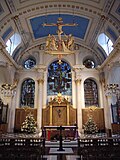Christopher Wren
Sir Christopher Wren (20 October 1632 – 25 February 1723) was a 17th century English architect, designer, astronomer and geometer. He designed 51 churches in London after the Great Fire of London, including St. Paul's Cathedral.[1][2]
Sir Christopher Wren | |
|---|---|
 Wren in a portrait by Godfrey Kneller (1711) | |
| Born | 30 October 1632 [O.S. 20 October] East Knoyle, Wiltshire, England |
| Died | 8 March 1723 [O.S. 25 February, 1722] (aged 90) St James's, London, England |
| Nationality | English (later British) |
| Alma mater | Wadham College, Oxford |
| Known for | Designer of 54 churches including St Paul's Cathedral, as well as many secular buildings of note in London after the Great Fire |
| Scientific career | |
| Fields | Architecture, physics, astronomy and mathematics |
| Academic advisors | William Oughtred |
Wren was born on 20 October 1632 in East Knoyle, Wiltshire, England. He was educated at Westminster School and Oxford University. He showed an early talent for mathematics. He invented an instrument for writing in the dark and a pneumatic machine. In 1657, Wren was appointed professor of astronomy at Gresham College in London. Four years later, he was appointed professor of astronomy at Oxford. In 1662, he was one of the founding members of the Royal Society.
Wren developed an interest in architecture following his studies of physics and engineering. In 1664 and 1665, Wren designed the Sheldonian Theatre in Oxford and a chapel for Pembroke College, Cambridge. Thereafter, architecture became his main focus. In 1665, Wren visited Paris. He studied French and Italian baroque styles.
In 1666, the Great Fire of London destroyed much of the medieval city. Wren produced ambitious plans for rebuilding the whole area. His plans were rejected, partly because property owners insisted on keeping the sites of their destroyed buildings. Wren did design 51 new city churches, including a new St Paul's Cathedral. In 1669, he was appointed surveyor of the royal works. This gave him control of all government building in the country. He was knighted in 1673.
In 1675, Wren was commissioned to design the Royal Observatory at Greenwich. In 1682, he designed a hospital in Chelsea, London for retired soldiers, and in 1696 a hospital for sailors in Greenwich. Other buildings include Trinity College Library in Cambridge (1677 - 1692), and the facade of Hampton Court Palace (1689 - 1694). Wren often worked with the same team of craftsmen, including master plasterer John Groves and wood carver Grinling Gibbons.
Wren died on 25 February 1723. He was buried in St. Paul's Cathedral. His gravestone features a Latin inscription which translates as: 'If you seek his memorial, look about you.'[3]
Gallery of architectural work
| Wikimedia Commons has media related to Lua error in Module:Commons_link at line 62: attempt to index field 'wikibase' (a nil value).. |
Christopher Wren Media
Wadham College, Oxford, where Wren was a student in 1650–51
Wren, portrait c. 1690 by John Closterman
Wren spent a portion of his scientific career at Gresham College
St Bride's Church (1670–84)
Royal Hospital Chelsea (1682–92)
Hampton Court (1689–1702)
The Wren Library at Trinity College, Cambridge, is one of a number of the architect's commissions that now bear his name
References
- ↑ Tinniswood, Adrian 2001. His Invention so furtile: the Life of Christopher Wren. Oxford University Press. ISBN 0-19-514989-0
- ↑ Vaughan Hart. 1995. St Paul's Cathedral: Sir Christopher Wren. Phaidon, London. ISBN 0714829986
- ↑ BBC: Christopher Wren




























































